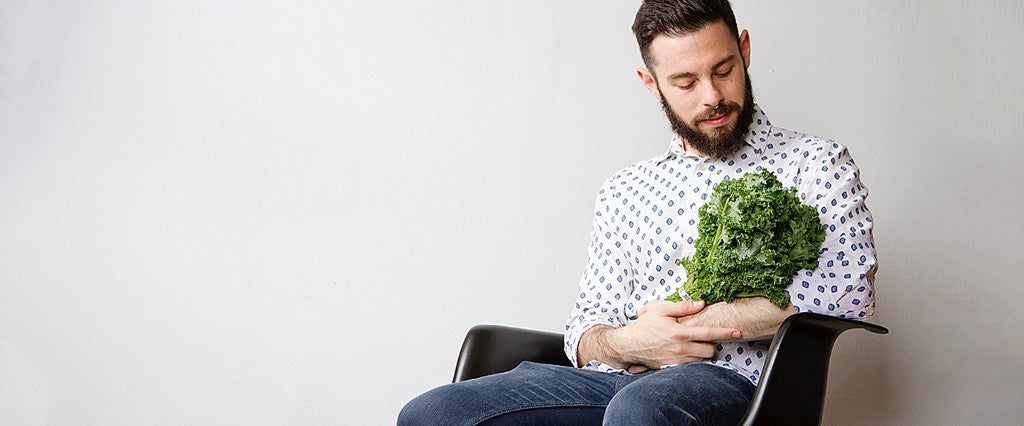Satirical photo shoots that mimic the clichés of traditional life milestones — spoofing weddings and babies, mostly — were a bit of a thing this year. There was the woman who did an engagement-style photo shoot to celebrate a dream job, and the bridal-style photo shoot celebrating a woman’s recent divorce. There was the cake-smash style shoot in the tradition of a baby’s first birthday, for a woman’s 30th. And another gal posed napping and clutching booze to celebrate her child-free life for the #nonmotherhoodchallenge.
Nearly all these up-yours style photo shoots are done by women, and it’s obvious why from a cultural standpoint: Women still endure far greater societal pressure to marry and procreate, and far greater scrutiny when they opt out, even though a recent national study found that more men want children than women. So when 31-year-old Torontonian Andy Prosserman styled a tongue-in-cheek photo shoot of his own, it still came off as novel— mainly because Prosserman is a dude, but also because of what he was celebrating: his vasectomy. Photos of him posing with a bundle of kale, a bottle of Scotch, a Nintendo controller, his passport, and his cat — objects that, for Prosserman, define freedom in emerging adulthood — symbolize his joy in the decision to remain child-free. The choice to get a vasectomy is not one we ask men to declare publicly (16 percent of men between 36 and 45 get them), nor do we generally expect men to justify the choice to not have kids as if it’s going against the grain. That’s not lost on Prosserman, who said he never felt any pressure to have kids in the first place.
“I’m in a very lucky situation in that sense,” Prosserman told me by phone. “My family doesn’t care that much. They’ve never pressured me, and basically said do what you want to do. My dad had two vasectomies, so he understands why I would want one. Everyone is very much supportive of whatever life choices I make in general.”

The genesis for the shoot was a joke. Prosserman, 31, began noticing the Facebook feed onslaught of the classic photo spreads of his friends getting married and becoming parents and had an idea. “I enjoy and appreciate absurdity, and I thought it would be really funny,” he said. “People do all these cheesy photo shoots after having a baby, and this was also a big decision for me, so I figured I’d do the same thing, just kind of the opposite.”
Prosserman had always known he didn’t want kids — he and his girlfriend “high-five to no kids on a regular basis” — but he didn’t know what to expect with a vasectomy. “I thought personally I would have a harder time than I did,” he said. “But then I was excited about how easy it was to go through it.”
Prosserman simply made an appointment with his general physician and said he wanted to get the procedure done. “He didn’t second-guess me at all,” Prosserman said. “He said, ‘Okay, I’ll schedule you.’ He put it in the computer, and a week or two later they called me from the clinic and said I was in.”
Next, he met with a surgeon who explained the basics to him. “She emphasized it was permanent, and I do think she was gauging my state of mind, at least in terms of whether I seemed sound of mind, and what medications I might be taking, and if I suffered from depression or anxiety. But mostly, it was a friendly chat. There was no probing of any kind. It was pretty straightforward.”
Compare this with the experiences women who seek out tubal ligation, the female equivalent of the vasectomy. In 2012, Slate explored why it’s so difficult for women, particularly in their 20s and 30s, to get their tubes tied, and why they face stonewalling, discouragement and outright refusal to perform the procedure from physicians both male and female.
The reasons are complicated and numerous, and some of it comes down to biological differences. One, a vasectomy is a simple procedure that can be done under local anesthesia. Getting your tubes tied is a more complicated abdominal surgery requiring general anesthesia and possibly an overnight hospital stay, which makes it riskier, with a longer recovery time. Vasectomies are also less expensive ($800 on the low end, compared with $5,000 for a tubal ligation). They have a lower failure rate: 0.02 percent to 0.2 percent, as compared to 0.73 to 1.85 percent for tubal ligation. And vasectomies also have a higher reversal success rate: 95 percent for turning the sperm tap back on, compared with 40 to 80 percent reversal rates for tubal ligation, depending on the woman’s age and any scarring to the Fallopian tubes during the procedure. (Neither successful reversal guarantees a future pregnancy, though.)
Finally, and this may be the most compelling reason tubal ligation is discouraged more often: Studies find that the younger a woman is when she gets a tubal ligation, the more likely she is to regret it. A study of sterilization outcomes found that women under 30 have a 20.3 percent chance of regretting it later. (Over 30, that regret is reduced to a 5.9 percent probability, though only 1.1 percent of women actually request a reversal 14 years after the procedure.) Meanwhile, one study put the vasectomy regret rate at two out of every 100 men.
All this may be why the American Congress of Obstetricians and Gynecologists advises physicians to counsel women to “discuss their decision with their husband or other appropriate intimate partner” and why most comparisons net out that if you’re making the decision as a couple, vasectomies are simply safer and easier a method. Of course, if you’re single, that’s useless. Still, adult women ought to be able to make this call armed with all that information, but it’s just not the case.

“I suffered no pushback whatsoever,” Prosserman says. “But my friend Samantha has been trying to get a consultation for tubal ligation for years, and they won’t even entertain the conversation,” he said. “Let alone put her through the surgery.”
That difference explains some of the comments from women on his Facebook page that the shoot was awesome, but “I wish my doctor respected me the same way.” Others suggested it wasn’t cool to be showing off a freedom of low-pressure ease and access to a procedure that so many other people don’t have. Prosserman insists he didn’t mean to offend anyone, but as a result of that reaction, he wants to use the attention to address these issues.
“I think there’s just a big-time societal double standard in terms of family pressure, social pressure, medical and political pressure on women,” he said. Plus, part of the reason we don’t see men celebrating childless freedom so adamantly is that we often don’t expect fathers to give up those freedoms to the same degree after becoming parents. Women still do the majority of the housework and child-rearing even when men want equal sharing. So it’s also more likely that, as a man, Prosserman would not have necessarily have to give up booze, travel, video games, or kale just to be a dad.
“It’s true,” he says. “I could still do all these things. It’s more that I just don’t want a baby.”
That doesn’t mean he should want kids. But when asked why — hey, it’s only fair, people ask women this stuff all the time — he answers firmly. “Some people at their core just don’t want children, and I don’t think it warrants any more of a justification,” he said. “No one should need a reason.”
Which is exactly what so many women have been saying for years.

